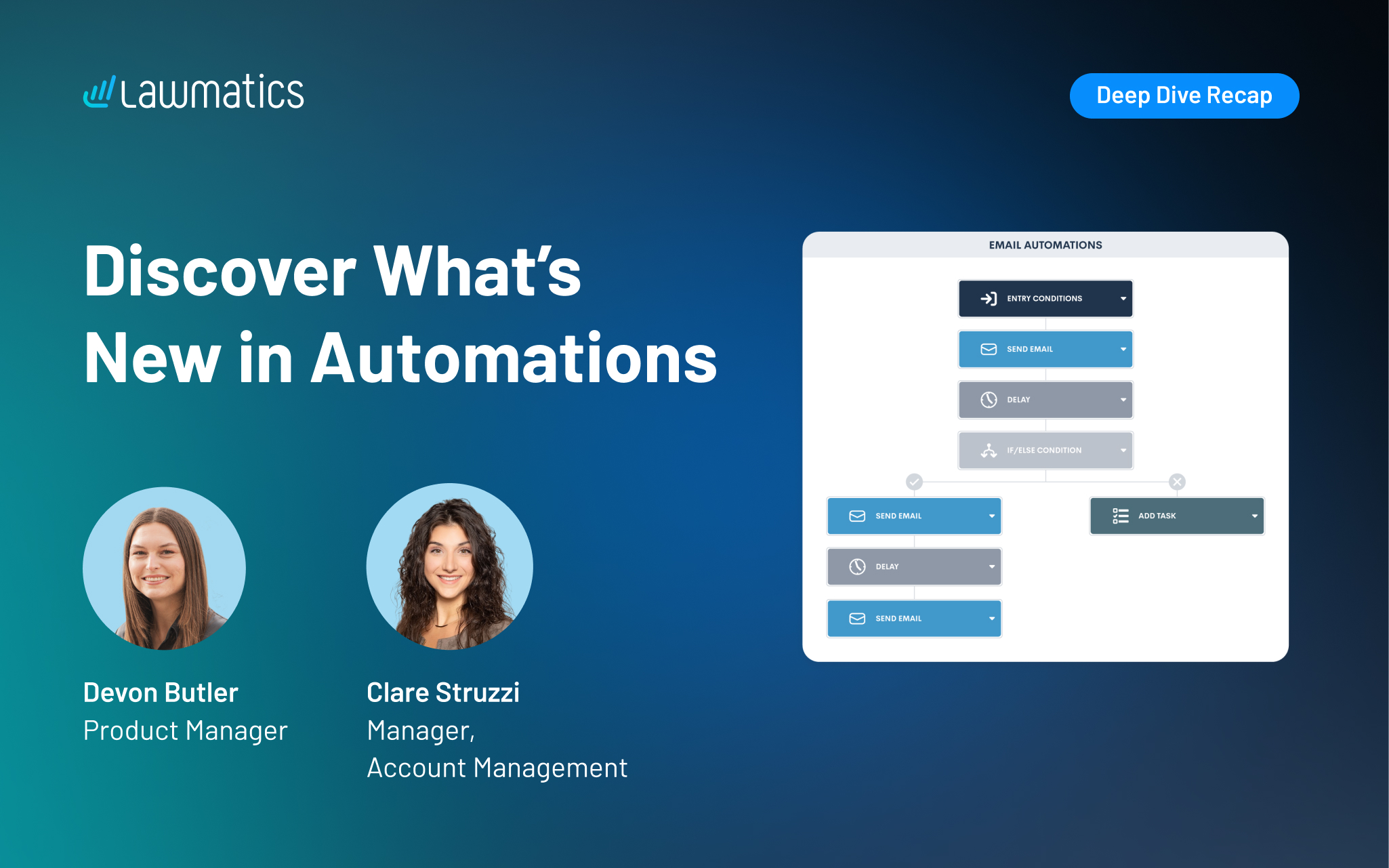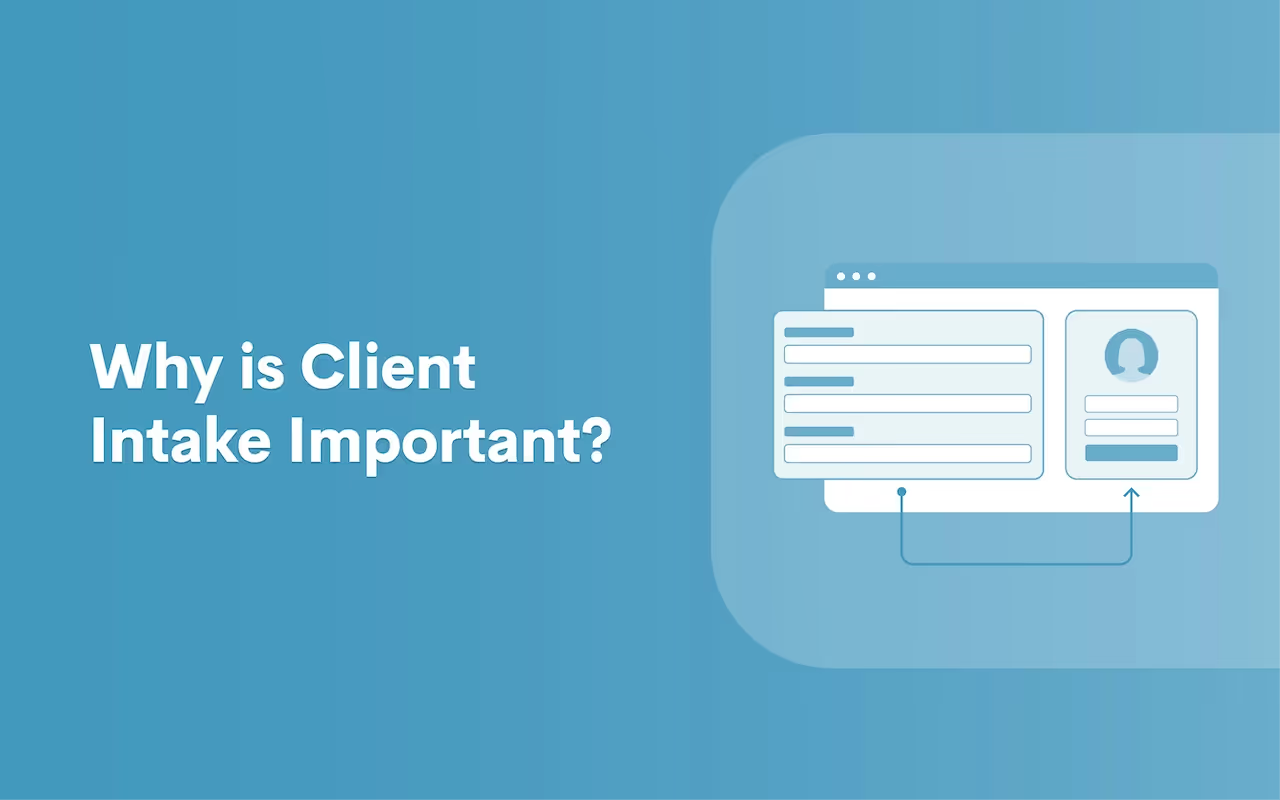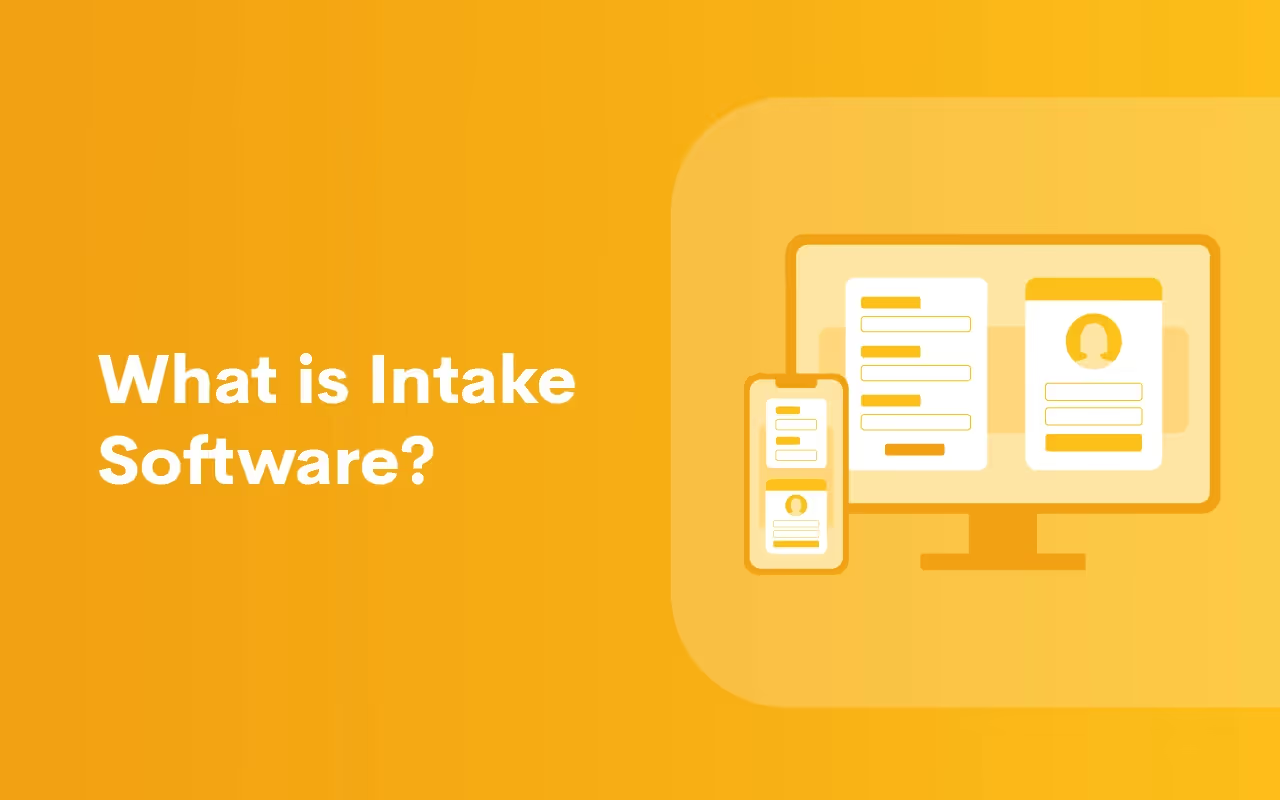The Lawmatics Blog
Insights on legal marketing, automating the law practice, and legal tech in general
About the session
Behind every great client experience is a system quietly keeping things on track. The newest automation updates in Lawmatics build on that foundation, making it even easier to build and manage their automated workflows.
In this session, Devon Butler and Clare Struzzi walk step-by-step through what’s new. They cover trigger-based automations, appointment workflows, shared entry rules, and a simple way to organize everything in folders. Together, these improvements give firms even more control, flexibility, and time back in their day.
Webinar slide deck
As the May flowers bloom, we’re excited to unveil our latest feature release! From customizable headers and footers to tailored event management and personalized matter table columns, our slate of updates will help you thrive in this season of growth.
Enhance your brand with document headers and footers
Personalize your Start Fresh documents with our new header and footer templates. Under Settings > Firm Settings > Document Headers And Footers, you’ll find a new tab to easily create professional headers and footers for any Start Fresh document. Once you've created your custom templates, applying them is a breeze — simply select the desired template when creating or editing a document and let Lawmatics handle the rest. Take the tedium out of drafting documents, and impress your clients with polished paperwork every time.

Click here to learn more.
Limit event registrants
Make managing every event stress-free with our new registrant limit feature. Ideal for small gatherings and exclusive events, you can now customize attendance limits for individual events or set default limits for each event type through your event settings page. Once the limit is reached, this functionality automatically prevents further registrations. With Lawmatics holding the velvet rope, enjoy peace of mind and the freedom to craft engaging experiences for the clients, partners, and community members in attendance.

Click here to learn more about event management.
Choose which columns appear on your matter table
In our previous release, we introduced the flexibility of filtering your matter table views. This month, we’ve unleashed even more customizability by allowing any of your Lawmatics fields to display as columns in your matter table. This enhancement gives you complete control over your data presentation, making it easier to organize and access the information that matters most to you.

Click here to learn how to create filtered views.
Assign roles based on appointment host
If the host can vary for each potential client’s appointment, you need accurate records of which team members were involved with each case. Our upgrade to the “Change Attributes” effortlessly automates this attribution record. With this feature, you can automatically update user fields to reflect the appointment host. Previously, assigning user roles, like Lead Attorney or Salesperson, based on the appointment host could only be done manually. This addition ensures that your user roles are accurately assigned, saving you time and reducing manual updates.

Click here to learn more about automation action nodes.
Create email templates for each invoice type
Upgrade your invoice email communication with our new templates. Previously, firms were limited to a single generic invoice email template. Now, by navigating Settings > Invoices > Invoice Types, you can create distinct email templates for each invoice type, both online and offline. Simply click the icon next to each invoice type to set up your customized templates. This feature delivers professional, personalized, and consistent invoices that meet the unique billing needs of your firm.

NOTE: This feature is only available for Time & Billing users.To learn more about invoices and time tracking click here.As always, we love your feedback and encourage you to reach out with any questions or suggestions. Thank you for being a valued member of our community. Together, we continue to push the boundaries of what's possible for law firms.Sign in or sign up to get started with Lawmatics today.
Automating the legal client intake process can greatly streamline your workflow, improve efficiency, and allow you to retain more clients. Here are some ways you can automate this critical process:
- Online intake forms: Create online intake forms with dedicated legal practice management software. Customize your forms to gather all necessary client information, such as contact details, case details, and legal documents.
- Document automation: Use document automation software to generate standard legal documents based on the information provided by the client in the intake form to save time drafting routine documents.
- Client portals: Implement a secure client portal where clients can securely upload documents and communicate with your firm to streamline document sharing and communication processes.
- Email automation: Set up automated email responses to acknowledge receipt of the client intake form and provide further instructions or next steps. Email automation tools can be used for this purpose.
- Integration: Integrate your intake forms with your customer relationship management (CRM) and case management software to automatically create client records and populate relevant case information.
- Workflow automation: Utilize workflow automation tools to automate repetitive tasks associated with client intake, such as creating tasks for team members, scheduling appointments, or sending reminders.
- Electronic signature software: Use electronic signature software to obtain signatures on time-sensitive intake forms and engagement agreements remotely.
Legal client intake automation allows firms to customize every aspect of the client intake process, including follow-ups, appointment scheduling, document requests, and more.
What is included in the client intake process?
The client intake process typically includes:
- Initial contact: The client reaches out to the law firm through a phone call, email, website contact form, or in-person visit.
- Pre-screening: The firm performs a basic assessment to determine if the potential client's issue falls within the firm's practice areas and checks for conflicts of interest.
- Initial consultation: The attorney meets with the potential client to gather more information about the client's legal issue, explain the legal process, assess the merits of the case, and discuss fees.
- Client intake form: The client fills out a detailed intake form providing personal information, contact details, and specifics about their legal matter.
- Retainer agreement: The attorney and client enter into an agreement that outlines the terms of representation, scope of services, fees, and payment arrangements, and other relevant terms.
- File and billing setup: A client file is created containing all relevant documents, correspondence, and notes related to the case. Billing arrangements are also set up, which may include retainer payments, hourly rates, flat fees, or other fee structures.
- Communication plan: The attorney and new client agree on a communication plan, including how often they will communicate, preferred methods of communication, and who to contact for updates.
A client relationship management (CRM) system manages the entire client intake process by automating client follow ups, email workflows, appointment scheduling, document creation, and other tasks that would otherwise require time-consuming manual procedures. Using the right tool helps law firms effectively onboard a new client.
How do you develop an intake process for a law firm?
Developing an effective intake process requires careful planning. Firms must determine the primary objectives of the intake process, analyze the needs of target clients, determine the information that you will need to gather during intake, create the forms that will capture the information, and develop the standard operating procedures it will follow.All the departments in a law firm should take part in customizing the intake process. It is extremely important to create a lawyer intake process that is personalized for the law firm and its practice areas rather than just relying on a generic template. Technology platforms like document automation software, online scheduling tools, and electronic platforms can greatly streamline the process.
How can we improve the intake process?
Firms can improve the intake process by creating a step-by-step flowchart or law firm intake script that maps out intake from initial contact to case closure. This outline should identify key touchpoints and required actions at each stage of the process.Intake training for law firms provides guidance to staff members who are responsible for handling intake inquiries. It should offer information on how to use intake forms, conduct pre-screening, gather information, and address common client questions.
What is client intake software?
Legal client intake software is a specialized tool designed to streamline and automate the process of onboarding new clients for law firms. It typically includes features and functionalities tailored to the unique needs of legal intake.While free client intake software for law firms might seem like a good option for small firms, it often comes with limited features and functionalities compared to paid solutions. Free intake software might also lack the capability to scale with the growth of your firm, may offer limited or not customer support, and lack the robust security measures found in paid solutions.
Automate your client intake with Lawmatics
Lawmatics makes it easy to create your own intake process and efficiently capture the client information you need. By establishing a clear and consistent process for client intake, you can save time, eliminate troublesome errors, and keep everyone in your law firm on the same page. Are you ready to learn more? Request your free demo today.
Effective legal client intake is more than a mere formality—it's the bedrock of a thriving attorney-client relationship. This critical process isn't just about gathering data; it's an opportunity to deeply understand the client's legal dilemmas and aspirations. By tailoring legal advice and representation to meet these unique needs, attorneys can set clear expectations right from the start—ensuring clients feel informed and reassured about the journey ahead.However, let's face it: crafting an efficient intake process can be a real challenge, especially when it's done the old-fashioned way. It can also be inconvenient for clients, who don’t like to print out a client intake form pdf for a law firm, instead preferring a simplified process featuring automated legal client intake software. By embracing technology to streamline the intake process, law firms can cut down on tedious administrative tasks and boost accuracy, allowing lawyers to focus on what they do best—advocating for their clients. Automation not only fast-tracks case merit assessment and conflict identification but also ensures rigorous compliance with legal standards.
What does client intake do?
Legal client intake gathers information from potential clients regarding their personal background, legal issue, and other relevant data. So, why is client intake important? In addition to the reasons we’ve already covered, it gives lawyers the opportunity to evaluate several important things about a client and their case before they extend representation, such as:
- Case merit. Intake gives lawyers the opportunity to assess the legal merits of the client's case by evaluating the strength of the legal arguments, the availability of evidence, and the likelihood of success in litigation.
- Client expectations. Effective client intake helps manage client expectations by explaining the legal process, potential outcomes, and the role of the lawyer. This transparency fosters trust and helps avoid misunderstandings later in the legal process.
- Potential conflicts of interest. Client intake procedures allow lawyers to identify any potential conflicts of interest that may arise from representing the client. This is important for maintaining ethical standards and avoiding legal and professional complications.
- Compliance. Legal client intake helps ensure compliance with regulatory requirements and ethical standards. It involves documenting important information about the client, their case, and the representation agreement, which is essential for record-keeping and accountability.
- Risk management. Thorough client intake helps lawyers identify and mitigate potential risks associated with the representation. This includes assessing the financial risk, the complexity of the case, and any other factors that may impact the lawyer's ability to effectively represent the client.
Legal client intake automation delivers a client-friendly intake process that produces better results by leveraging technology. Some platforms even integrate with other legal apps your firm may already be using, like case management software, making your job even easier.
What is an intake process for a law firm?
The meaning of client intake refers to the process by which a law firm obtains information from potential clients to evaluate their legal needs, determine whether the firm can provide appropriate representation, and establish the foundation of the attorney-client relationship.
What is intake information?
Potential clients are often asked to complete a law firm client questionnaire. This document collects detailed information about the potential client’s background, the nature of their legal issue, relevant dates and events, and other pertinent details. Some legal client intake form examples include paper and digital formats, fillable PDFs, and customizable online forms.Automated client intake form templates make it easy to create your own intake process and efficiently capture the client information you need. Simply define the details you want to collect based on your practice area and case type and build custom templates. The more details that are requested on an intake form, the better a lawyer can qualify a lead before setting an appointment.
How do you create a client intake process for a law firm?
Creating a client intake process for a law firm involves ensuring it is thorough, efficient, and compliant with legal and ethical standards. Here's a basic framework:
- Determine necessary information. Identify the information you need from potential clients to evaluate their case and determine whether you can provide representation.
- Create a form. Design a digital or paper intake to collect the necessary information systematically. Consider using online forms for ease of submission and organization.
- Customize for practice areas. Tailor your intake process to your firm’s specific practice areas. Different types of cases may require different information or evaluation criteria.
- Implement screening procedures. Develop screening procedures like conflict checks to assess potential conflicts of interest and evaluate the viability of the case.
- Establish follow-up protocols. Decide how you will follow up with potential clients after the initial intake to gather more information, clarify details, and discuss next steps.
- Keep records. Maintain detailed records of all communications with potential clients, including intake forms, correspondence, and notes from meetings or phone calls.
Optimize your intake process with Lawmatics
Lawmatics legal intake software helps create seamless client intake processes and can streamline other important workflows as well. Are you ready to give your clients the intake experience they deserve? Request your free demo today.
Legal client intake software is a type of technology specifically designed to streamline the process of collecting information from clients or potential clients in the legal industry. Legal client intake automation is typically used by law firms, legal departments, or legal service providers to efficiently gather relevant details about a case or legal matter during the initial consultation or intake process.
What is intake software used for?
Legal intake software is used to improve efficiency, productivity, and client satisfaction in the intake and case management processes by automating the following routine tasks:
- Forms: Legal software solutions often provide customizable online intake forms that clients can fill out electronically. These forms can be tailored to gather specific information relevant to different types of legal cases.
- Manual processes: Legal intake software provides tools for automation of the intake process to reduce manual data entry and streamline procedures. This may involve automatically populating client information into case management systems or other databases.
- Document management: Some legal intake software platforms provide document management capabilities that allow users to securely upload and store important documents related to the intake process.
- Client communication: Legal intake software solutions frequently feature tools for communicating with clients, such as automated email or text message reminders, updates, and notifications.
- Integration: Integration with other software systems commonly used in law firms, including case management software, customer relationship management (CRM) systems, or billing software, is another valuable feature of legal intake software.
- Data security and compliance: Legal intake software systems must prioritize data security and compliance with legal regulations, such as client confidentiality requirements outlined by bar associations or data protection laws.
Legal intake software creates a repeatable process that allows law firms and legal departments to spend more time on billable work.
What is the purpose of an intake software?
Legal client intake software helps legal professionals manage and organize client intake information more efficiently to improve client satisfaction and streamline the overall legal workflow.
What is the most popular legal software?
Best-in-class tools for legal client intake, workflow & marketing automation, legal billing, document management, and more are fundamental to the success of your law practice. Some of the most popular legal software systems include Clio, Lawmatics, MyCase, PracticePanther, and Smokeball. Lawmatics integrates with these and other legal tech applications and many intake software systems to help lawyers run their firms more efficiently.
How much does legal software cost?
The cost of legal software varies depending on the type of software, the features included, the size of the law firm or legal department, and whether it's a one-time purchase or a subscription-based service:
- Subscription-based software: Users pay a monthly or annual fee ranging from a few dollars per user per month for basic features to hundreds or thousands of dollars per month to access the software.
- One-time purchase: Some legal software may be available for a one-time purchase, where users pay a one-time fee to buy the software outright. These costs can vary widely depending on the complexity and features of the software, ranging from a few hundred dollars to several thousand dollars or more.
In addition to the base subscription or purchase price, there may be additional costs associated with legal software, such as setup fees, training fees, customization fees, and fees for additional users or features. Different software vendors may have different pricing models and pricing tiers based on number of users, level of support, and features included. Law firms and legal departments should carefully evaluate their needs, budget, and the features offered to make the best decision regarding legal software.
What type of software do attorneys use?
Attorneys use a variety of software applications to streamline their workflow, including:
- Case management software: To organize and manage cases, track deadlines, store documents, manage client information, and assign tasks.
- Document management software: To create, store, organize, and collaborate on legal documents electronically.
- Time and billing software: To track billable hours, generate invoices, and manage client billing information.
- Practice management software: To manage client intake, case management, document management, billing, and accounting.
- Legal calendaring software: Legal calendaring software helps attorneys manage court deadlines, hearings, appointments, and other important dates. It can sync with other calendar applications and provide reminders to ensure compliance with deadlines.
- Communication and collaboration tools: To communicate with clients, colleagues, and other stakeholders via email, instant messaging, video conferencing, and secure client portals.
- Conflict checking software: To identify potential conflicts of interest before taking on new clients or cases.
The best legal software systems, like Lawmatics legal CRM, are all-in-one platforms that help law firms drive efficiency, attract more prospects, increase client engagement, and accelerate growth.
Lawmatics: the best legal intake software for your firm
Are you ready to elevate your client intake experience and maximize firm revenue with the #1 CRM for law firms? Request a Lawmatics demo today.
Legal client intake forms are critical for an efficient client onboarding process. Firms traditionally created their intake forms manually, legal client intake software improves efficiency, reduces time spent on administrative tasks, and enhances the client experience.
How do you draft an intake form?
Lawyers and law firms create intake forms to gather necessary information from clients as efficiently as possible. Here are some steps to take when drafting your intake form:
- Identify necessary information: Determine the information you need from clients to properly assess their legal needs and proceed with their case. Common elements include:
- Personal information: Name, address, phone number, email address, date of birth.
- Case-specific information: Brief description of the legal issue, date of incident, parties involved, relevant documents.
- Financial information: Billing address, payment method, fee agreement details.
- Design the form: Create a clear and concise form that is easy for clients to fill out. Use sections and headers to organize information logically. You may use software like Microsoft Word, Google Forms, or specialized legal practice management software to build the form.
- Include legal language and disclaimers: Incorporate necessary legal language and disclaimers to protect both parties. This may include confidentiality statements, attorney-client relationship disclaimers, and consent to representation sections.
- Make the form accessible: Ensure the intake form is easily accessible to clients by providing it on your website for online submissions, emailing it to clients, or having physical copies available at your office.
- Ensure compliance: A legal client intake form must comply with ethical requirements for avoiding client conflicts, protecting client confidentiality, and data protection laws.
- Review and update regularly: Periodically review and update the intake form to ensure it captures all necessary information and complies with any changes in laws or regulations.
Traditionally, legal client intake involved having new law firm clients fill out a paper form painstakingly typed out by a staff member. However, there’s no reason to struggle with printing, scanning, or photocopying client intake forms. With the right tools and approach, client intake automation can make these processes more efficient and create a personalized experience for clients. By utilizing automation, law firms can empower themselves to make the most of technologies and improve their business.
How do I create a custom intake form?
Creating a custom legal intake form involves tailoring the form to your specific practice area, client needs, and preferences. Here's a guide:
- Identify your practice area: Determine the focus of your legal practice to help you tailor the form accordingly.
- Outline necessary information: Make a list of the information you need from clients to effectively assess their legal needs and proceed with their case.
- Customize sections and questions: Tailor each section and question to your specific practice area and client needs. Use clear and concise language, and organize questions logically to make it easy for clients to understand and complete the form.
You can create the structure and layout of your intake form by creating a physical document or using a digital platform. You can build an approachable yet all-encompassing intake form for all practice areas and matter types with legal intake software to accelerate and simplify the intake process for you and your prospective clients and achieve a higher close rate.
How do I create a new client form?
By following the steps outlined above, you can create a new client form that efficiently collects essential information from clients while protecting their rights and interests—as well as those of your law firm. While manually creating a new client form can be time-consuming and labor-intensive, legal intake software simplifies and automates a significant portion of these often inefficient tasks.
Can I use Google Forms for client intake?
While law firms can use one-size-fits-all Google Forms, a legal client intake form template from Word, or free online intake forms, custom client intake form templates for law firms allow you to specify the details you want to collect, based on your practice area and case type. The software can screen potential clients for you as they answer your questions, and even create follow-up questions based on the responses. Once you’ve followed up, automated appointment scheduling will help the potential client set up a consultation. If they are a fit, the software will automatically generate the paperwork to finalize the attorney-client relationship. Custom legal intake software streamlines your intake process so you can prioritize casework.
What is a typical intake form for a law firm?
A typical intake form for a law firm aims to gather essential information from prospective clients efficiently and comprehensively. Lawmatics intake form template conforms to each law practice’s needs, making it easy to qualify new prospects, organize contact information, and automate processes.Want to give your prospects the customer-focused intake experience they deserve? Get a Lawmatics product demo today.
Creating an effective intake process for a law firm is crucial for efficiently managing client inquiries, ensuring that relevant information is gathered, and setting the stage for successful client representation. Legal client intake automation and the use of an intake process template can streamline the process by leveraging technology to automate repetitive tasks, reduce manual effort, and improve efficiency in managing client inquiries and information.
What is the intake process for a law firm?
A law firm’s most common intake process definition: the procedure used to manage and respond to inquiries and requests for legal services from potential clients. The intake process serves as the initial point of contact between the law firm and potential clients, laying the foundation for establishing a professional relationship.
What are the phases of the intake process?
The intake process involves several phases, including:
- Responding to client inquiries
- Gathering client details
- Conducting conflict checks
- Assessing the merits of the case
- Scheduling consultations
- Meeting with clients
- Beginning representation
A well-defined and executed intake process is essential for managing client inquiries, facilitating the delivery of legal services, and enhancing the success and reputation of the law firm.
How do you create an intake process?
Inquiries from potential clients must be managed efficiently so that firms retain new clients and individuals obtain legal representation. Here’s a guide on how to create an effective intake process:
- Define goals and objectives: An intake process should aim to efficiently capture client information, evaluate the potential cases, and initiate the client engagement process.
- Identify critical information: Determine what information is essential for evaluating potential cases and initiating client representation, including:
- Basic contact information (name, phone number, address, email)
- Details of the legal issue
- Relevant documents or evidence
- Design forms: Create physical or digital intake forms or questionnaires that are user-friendly, easy to understand, and capture the required information.
- Establish intake channels: Determine how clients can submit their intake information. This could be through:
- Phone calls
- Email submissions
- Online intake forms on the firm's website
- In-person meeting at the firm's office
- Automate where possible: Maximize technology to streamline the intake process and reduce manual effort by utilizing:
- Online intake forms with automated data capture
- Customer relationship management (CRM) software
- Automated responses to acknowledge receipt of inquiries
- Follow-up: Develop procedures for following up with clients after the initial intake, including confirming receipt of their inquiry, providing timelines, and scheduling consultations with attorneys.
Regularly review and evaluate your intake process to identify areas for improvement. Get feedback from clients and staff to find out what's working well and what can be upgraded.
What does the intake process include?
Typically, a law firm completes a number of intake process steps when onboarding new clients, such as:
- Initial contact: The potential client makes contact with the law firm, either through a phone call, email, website form submission, or in-person visit.
- Gather information: The intake staff or attorney collects essential information from the potential client that is recorded manually or through an intake process template.
- Conflict check: The law firm conducts a conflict check to ensure there are no conflicts of interest that would prevent them from representing the potential client.
- Evaluate issue: An initial assessment of the potential client's legal issue is conducted to determine whether the firm has the expertise and resources to assist.
- Schedule appointment: If the law firm determines that they can assist the potential client, an appointment is scheduled for further consultation or evaluation via a phone consultation, video conference, or an in-person meeting at the firm's office.
- Confirmation and follow-Up: The law firm confirms the appointment details with the potential client and provides any necessary instructions or documents for the consultation.
- Consultation: During the scheduled appointment, the attorney conducts a more in-depth consultation or evaluation of the potential client's legal issue.
- Secure the client: Based on the consultation, both the potential client and the attorney decide whether to proceed with formal representation. If both parties agree to move forward, the attorney-client relationship is established, and the representation begins.
- Engagement letter: The law firm prepares and presents an engagement letter or retainer agreement outlining the terms of representation. The potential client reviews and signs the agreement to formalize the relationship.
By following these steps, law firms can effectively manage inquiries from potential clients, evaluate legal issues, and initiate client representation in a systematic and efficient manner.
What is an example of an intake process?
Some examples of an intake process include sending confirmation emails to new clients, assigning and moving tasks into a team member’s workflow, and prioritizing tasks based upon deadlines. Lawmatics legal intake software makes it easy to create your own client intake process, efficiently capture client information with a client intake form template, and keep everyone at the firm on the same page.Are you ready to take the stress out of client intake? Sign up for a Lawmatics product demo today.
Subscribe to get our best content in your inbox
Ready to grow your law firm with Lawmatics?
Schedule a demo of legal’s most trusted growth platform.














.avif)
.avif)

.avif)
